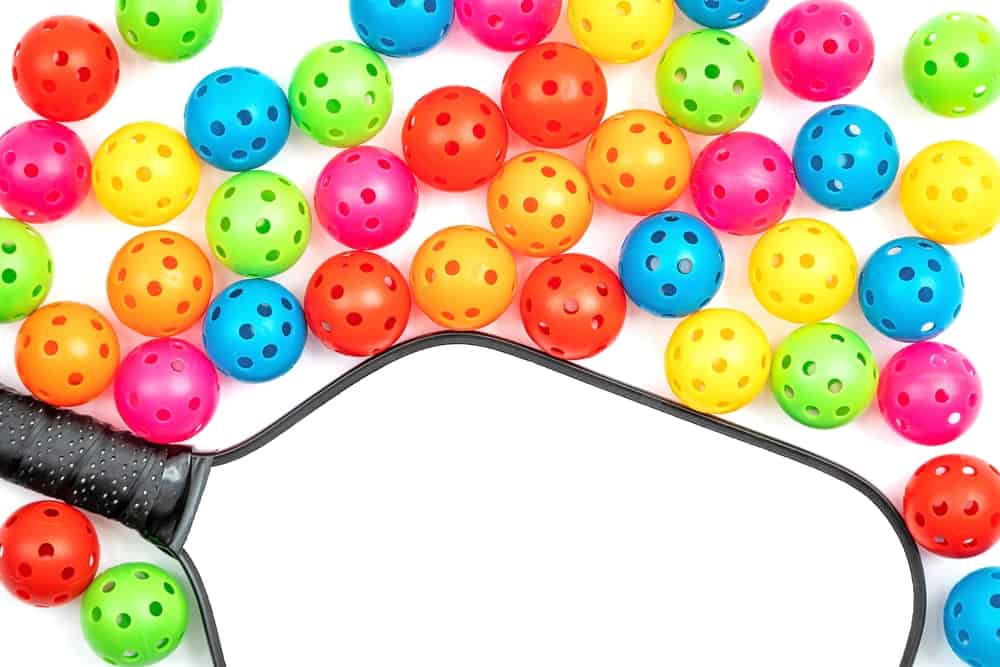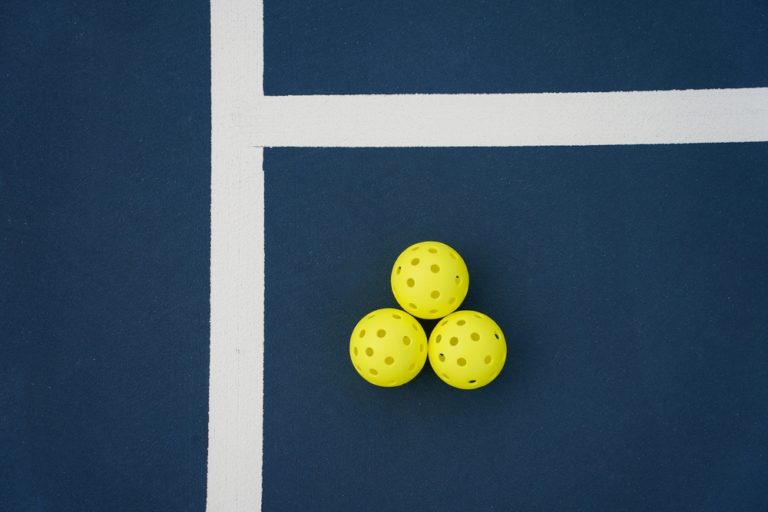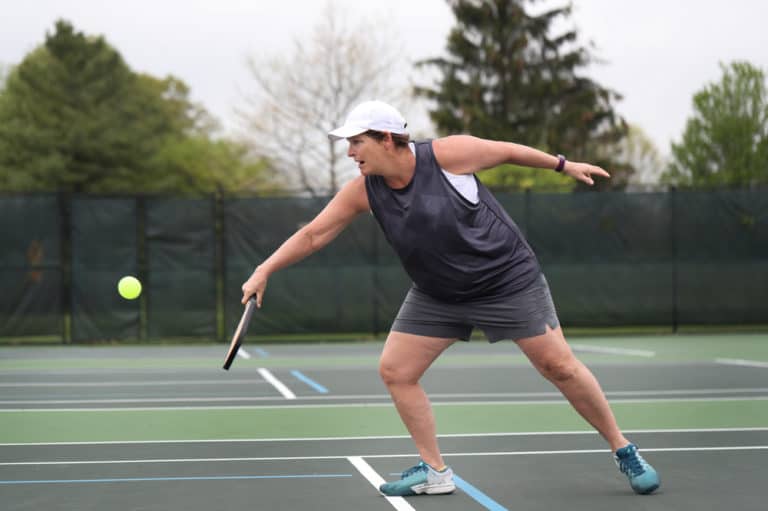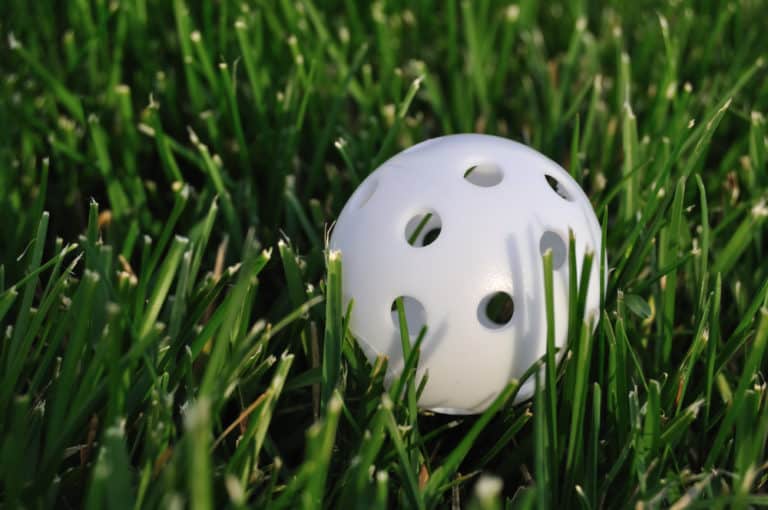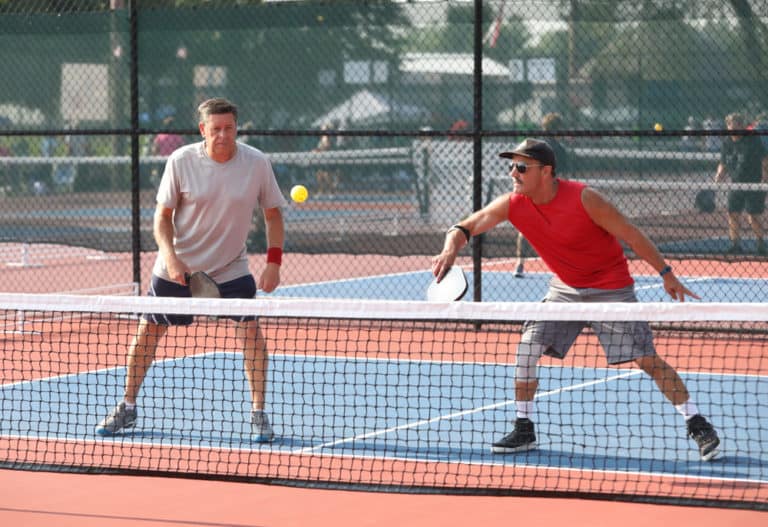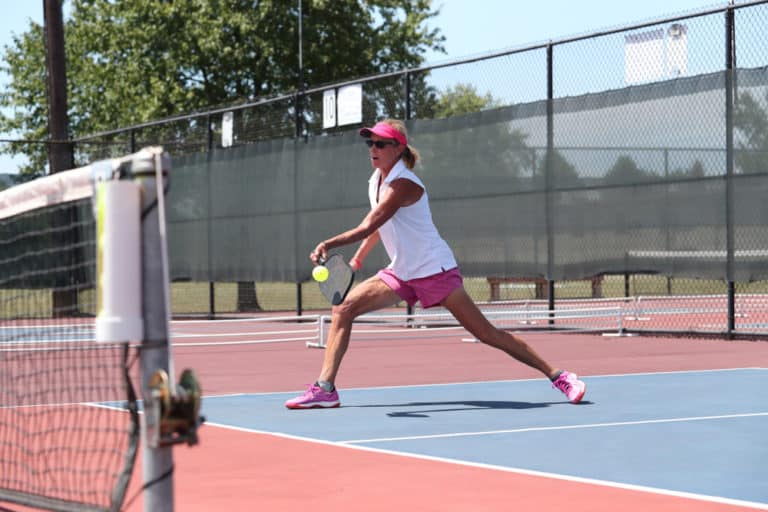What Is The Difference Between A Pickleball And A Wiffle Ball?
Pickleball balls and Wiffleball balls are only skin-deep; they possess subtle yet interesting differences that set them apart. When I play pickleball, I notice some people use wiffle balls – is that really possible? Let’s explore the differences between a pickleball and a wiffle ball.
The pickleball ball focuses on bounce to make contact with a paddle. They have fewer holes, 26 – 40, and a larger surface area that makes them heavier. The Wiffleball ball focuses on curved throws, has larger holes, 18 – 26 total, and less surface area, making them lighter.
If you plan to use a wiffle ball for your next pickleball game or vice versa, you’d want to know how it will affect your game, right? Let’s look at all the subtle differences of size, weight, shape, holes, and playability that set them apart.
How Does A Pickleball Ball And A Wiffle Ball Differ?
Pickleball balls have between 26 and 40 evenly distributed holes among their surface. They are generally vibrant red, yellow, or green, giving them superior visibility even in poorly-lit areas. Wiffleball balls are white, and the wholes exist only on one-half of the ball, plus they are longer than pickleball balls. Wiffleball balls have between 18 and 26 holes.
Depending on how players hold and throw a wiffleball, it will curve, and it can do so without wrist motion. However, pickleball balls don’t usually curve during play.
Design Differences Between Pickleball Balls And Wiffle Balls
The original ball used for the game of pickleball was, in fact, a wiffle ball. The USA Pickleball Association (USAP) and the International Federation of Pickleball (IFP) have since introduced a ball under pickleball-specific standards.
Pickleball Balls
Pickleball ball specifications must comply with a sturdy, smooth-surfaced molded material with between 26 and 40 equally spaced round holes. They must weigh between 0.78 and 0.935 ounces (22.1 and 26.5 g) and have a diameter of 2.87 to 2.97 inches (73 and 75 mm).
Tournaments sanctioned by the USAP and IFP must select from a list of preapproved balls available on the websites of the USAP and IFP.
Indoor pickleballs usually have fewer bigger holes, whereas outdoor pickleball balls have fewer but larger holes. There are also distinctions between the balls used because of the diverse variables impacting play between indoor and outdoor play, such as weight, plastic, and colors utilized.
Outdoor pickleballs come in three distinct weights and sizes, but their composition includes different sorts of plastic. For example, both the TOP and Dura Outdoor Pickleballs have a range of hole sizes and a more robust material for speedier play. These are the balls that high-level competition players like.
Wiffle Ball Balls
The Wiffle Ball is roughly the same size as a regular baseball, but it is hollow, lightweight, made of durable plastic, and only 1/8 inch (3 mm) thick. The perforated half has eight.75-inch (19 mm) oblong holes, whereas the non-perforated half has not. Pitchers may throw a wide range of curveballs and risers because of its design.
The wind impacts Wiffle balls despite having fewer holes than outdoor pickleball balls; wiffle balls are more affected by the wind. A ball’s flight is only affected when it spins, which is one of the intrinsic characteristics of a wiffle ball due to its shape.
When air passes through a Wiffle ball, part of it is caught inside it, generating an “interior vortex” effect that causes the ball to move. The unequal pressure distribution outside the ball caused by the holes can either compete with or complement this effect.
The pitching speed and the amount of spin the pitcher applies to the ball determine which effect—internal or exterior flow—predominates in the ball trajectory. At modest speeds, subtleties like ball scuffing may make a big difference.
This ball has a wide range of applications and provides a new experience with each pitch, hit, and fielding opportunity. You can do all kinds of interesting throws from the mound with little more than your hold – there are many pitches available! Curves, risers, knuckleballs, sliders, fastballs, change-ups, and a variety of other made-up pitches
Different Wiffle Ball Varieties
While pickleball balls are different in weight, size, aerodynamics, and number of holes, wiffle balls have different ball variations.
Wiffle Balls Without Holes
There are no holes in these balls, making them suitable for batting machines. It’s ideal since you can acquire consistent pitches via a device or by hand.
Because there is no resistance and these balls produce a lot of spins, they go significantly longer than ordinary Wiffle balls. Many balls travel 70 – 80 feet, then rise in height and go for another 40 feet or more.
These balls, in general, travel significant distances; they have the potential for consistent 150-feet strikes or even more. Due to the distance and their superior wind resistance, it feels excellent during playtime. They also have a pleasant sound and feel right away.
Wiffle Balls With Holes On Both Sides
Both sides have holes, and the goal is to have it travel on a straight trajectory. However, the balls don’t travel very far since the wind blows them down without the harder opposing side. Doing fancy tricks when you pitch is part of the fun, so these balls are not among the popular crowd.
Wiffle Ball Training Balls
There are two balls available: a Curveball and a training ball with holes on both sides. These are more rigid balls that may damage bats, so be careful if you have an expensive bat!
This ball is ideal for pitching machines since it is balanced and has holes on both sides. It has some movement but flies true off the bat, making it the most resembling a baseball. Additionally, since the ball is heavier and more challenging, it is less impacted by the wind.
If you hit the ball straight and it travels well, you can regularly hit 125 – 135 foot homers. They’re a good choice for batting machines because they’re pretty sturdy. At times, they may dent, but they quickly return to their original shape.
Wiffle Ball Curve Balls
It’s a lot of fun to pitch this ball because it moves! You can make this ball rise curve and do a lot because it is a complex and heavy ball. Don’t miss your place, though, since a good hit will go long. We’ve hit this ball 160 feet or more several times, and it always gets there quickly. This ball flies a long distance and does not perform well as a training ball.
This ball is not very durable and does not feed well from a batting machine. If you hit one with the end of the bat, the ball will dent, and it will not always pop back into position once damaged. After a significant quantity of wear, they also crack.
It’s also one of the most far-traveling balls available. However, as previously indicated, proceed with caution to avoid the sting on your body or damaging the bats.
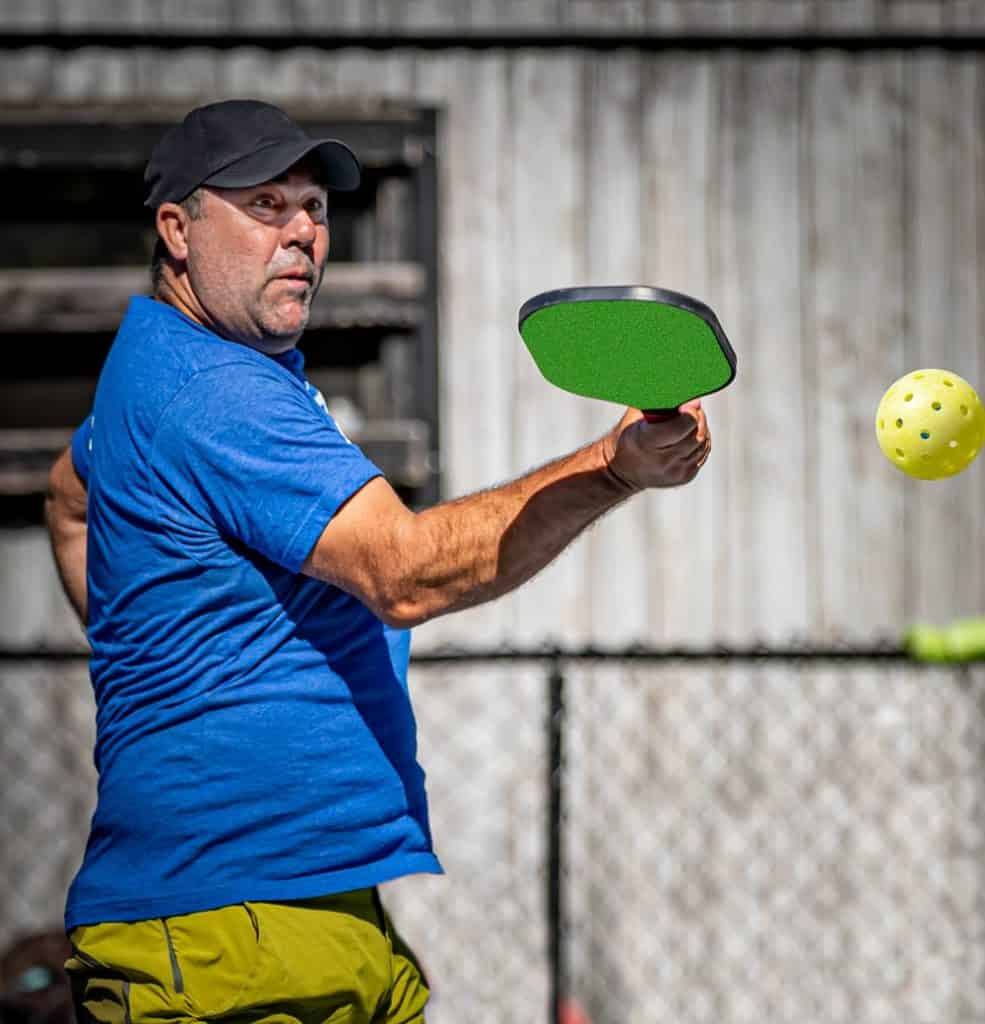
Why Do Pickleball Balls And Wiffle Balls Have Different Holes?
The perforations in the plastic balls used for backyard games increase the impact of air resistance by raising drag and reducing the mass (which lets the air resistance force cause a bigger acceleration).
As the ball’s peak speed grows, the force increases substantially, resulting in limited top speed. The holes have diverse forms as well. Pickleballs have circular holes, but wiffle balls have oblong holes.
Pickleball Balls
Indoor pickleball balls feature fewer holes, generally approximately 26, than outdoor pickleball balls. On the other hand, outdoor pickleball balls can contain up to 40 holes. Although having more holes, an outdoor ball is less sensitive to high winds and outside breezes.
Wiffle Balls
A genuine Wiffle brand ball has holes on one side and is solid on the other. A wiffleball ball’s holes give it the attributes that help curve when you throw it. As a result, it limits the speed of the ball, and it provides an effective force pushing toward the smooth side, which causes the trajectory to do strange things (like throwing curves).
Pickleball Balls And Wiffle Ball Materials
Pickleball and wiffle balls consist of Low-Density Polyethylene (LDPE), a recyclable Plastic Type #4. However, it primarily exists in plastic films, squeezable condiment bottles, and toys that contain LDPE. That includes shrink wrap and bags, such as those used for dry cleaning, supermarket, bread, frozen food, and vegetables.
On the other hand, outdoor pickleball balls are often heavier than wiffle balls. They are smaller and have greater material surface area while having more holes. When heavier objects are in motion, such as a pickleball ball flying through the air, they are more challenging to control.
When you drop a rock and a piece of wood of equal size into a body of water, the stone sinks right away while the wood floats away. In the same way, the amount of plastic on a ball dictates its flight path.
Wiffle balls are generally white and have an eight-hole design on the top half, with a solid bottom half. Their production process involves plastic beads the size of rock salt melted into liquid in a tube. Each hemisphere is inserted into its mold for shape before being heated together to produce a single Wiffle ball.
For this reason, Wiffle balls tend to cost more money because you would burn through a more significant number of them.
How Durable Are Pickleball Balls And Wiffle Balls?
Outdoor pickleball and wiffle ball should endure at least ten games before showing signs of wear and tear. Indoor balls have a longer lifespan since they are never exposed to the outdoors. Indoor pickleball balls acquire soft areas after being used for an extended period, even if they don’t break.
Pickleball’s dynamics shift through irregular wind patterns, fluctuating weather, and uneven playing surfaces. As a result, outdoor pickleball needs an exceptionally engineered ball to react to and manage these primary forces, ensuring that they do not destroy the game.
Outdoor pickleball balls are heavier than their indoor counterparts, weighing over 0.9 ounces. These balls are less prone to wear and tear due to their smooth surface and weight; however, it’s best not to play one ball for more than ten outdoor matches because the weather will cause the spin and bounce to deteriorate.
Outdoor pickleball balls have a higher bounce and are simpler to hit powerful strokes with when it comes to bounce. When playing with one, though, you may notice shorter rallies, less control, and less spin.
Wiffle balls break quicker than single-handed paddles because a vast, solid plastic bat strikes them. The wiffle ball will get damaged depending on the power of the batter. With this bat, I’ve broken wiffle balls.
Bounce Attributes For Pickleball Balls And Wiffle Balls
Pickleball is unique in that the ball must bounce during both the serve and the return of serve, negating some of the advantages of serving. So, even if you serve “out,” you have a higher chance of getting to the net when you return, where most points get awarded.
When you drop them from a height of 78 inches, the ball must have a particular bounce. The ball must reach a height of 30 to 34 inches when dropped from this height. In addition, it must be droppable upon a granite surface of 12 x 12 x 4-inches in a temperature range of 75 to 80 degrees Fahrenheit.
On the other hand, Wiffle balls have a unique 8-hole shape that focuses on making the ball react in unexpected ways, such as spinning when thrown.
A Pickleball’s Paddle Vs. A Wiffle Ball’s Bat
One of the most apparent differences between these two ball types is the instrument needed to give them motion.
Pickleball Needs A Paddle
Pickleball games take place on a court akin to that of badminton, with a raised net in the center. The ball is plastic and looks like a Wiffle Ball, although it’s usually a little smaller. Pickleball paddles, typically constructed of wood, are used to play the game (or other hi-tech materials).
There are no strict and fast regulations regarding equipment because the game is unlicensed and not frequently played in a highly competitive context; therefore, adequate alternatives may be employed.
Wiffle Ball Needs A Bat
Wiffle ball is a kind of baseball but played on a smaller scale. As a result, a perforated, lightweight, robust plastic ball and a long, often yellow, plastic bat is the instrument of choice to play the game. Similar to pickleball, you can play it both indoors and outdoors.
Conclusion
A pickleball ball and a wiffle ball differ in mass, color, number of holes, bounce. Pickleballs have larger holes and more surface area but fewer holes, while wiffle balls have larger holes and less surface area.
Sources
- https://en.wikipedia.org/wiki/Pickleball
- https://www.amazon.com/ask/questions/Tx1EABYCEFREYBK#:~:text=The%20pickle%20has%2028%20evenly,holes%20are%20longer%20in%20length.
- https://www.merchantoftennis.com/blogs/pickleball/10-things-you-should-know-about-pickleball
- https://en.wikipedia.org/wiki/Wiffle_ball#:~:text=The%20Wiffle%20Ball%20is%20about,other%20half%20is%20non%2Dperforated.
- https://www.forbes.com/sites/chadorzel/2016/06/07/why-are-there-holes-in-a-wiffle-ball/
- https://www.youtube.com/watch?v=-zBWenBrDp0&ab_channel=DarrellGrob
- https://www.reddit.com/r/Pickleball/comments/l0t7ib/pickleball_plastic_material/
- https://www.theatlantic.com/technology/archive/2017/09/wiffle-ball-physics/539982/
- https://www.wise-geek.com/what-is-a-wifflereg-ball.htm
- https://www.cbsnews.com/news/where-wiffle-balls-are-made/#:~:text=%22This%20is%20what%20the%20Wiffle,%22It’s%20called%20polyethylene.%22
- https://www.si.com/review/best-pickleball-ball/
- https://www.wired.com/2011/02/st-alphageek-ballistics/#:~:text=Wiffle%20balls%20are%20very%20poorly,practically%20bouncing%20around%20in%20midair

